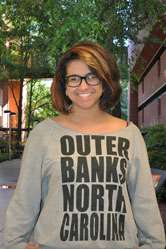History and Political Science
“The Dare Stones: Finding Eleanor”

This research examines the Lost Colony of Roanoke as an historical and cultural phenomenon, specifically looking into the origin of the Dare Stones in order to define the root of the Lost Colony’s appeal to Americans and as a part of North Carolinian folklore. Many know the tale of Walter Ralegh’s failed colony as a bedtime story or a popular legend due to the colonists’ mysterious disappearance and their subsequent failure to reappear in history. However, despite on-going research, nobody definitively knows what happened to the colony, thus laying the basis for many myths that surround the colonists today. My goal in this research is to discover how the legends began, and why people are so captivated by them. Why does the disappearance of 118 colonists five hundred years ago still matter? Why do people claim to be descended from Virginia Dare, the first English child born in America? This work is inspired by my fascination with the ways in which the Lost Colony is painted along the background of many of the legends and folklore of North Carolina, defining the way these people live and relate to one another. To achieve my goals, I will be specifically examining what are known as the Dare Stones and researching their history and continued influence upon the story of the Lost Colony. The stones are large rocks upon which Eleanor Dare, one of the colonists and the mother of Virginia Dare, supposedly carved their story following their disappearance from Roanoke. By interviewing historians previously and currently involved with Lost Colony research as well as locals of Manteo, North Carolina – modern-day Roanoke – I will piece together a picture of the Lost Colony’s past, present, and future. I hope to reveal the root of the legacy left to us by the first English settlers in North America.
How did you find your mentor for your research project?
I had taken Dr. Bouton’s 342 history class on the American Revolution as a freshman and loved the passion he had for American history. When I began looking for a mentor, he was one of the first professors who came to mind; I knew he would have invaluable insight into not only the research process, but into the specific research I hoped to carry out.
How did you know this was the project you wanted to do?
The Lost Colony is a story I grew up with, having spent much of my time growing up at the Outer Banks, North Carolina. During a stay there September of 2012, I visited Manteo and was intrigued even more by the mystery of the missing colonists. Interestingly enough, however, few people I spoke to outside of North Carolina had ever heard of the story – and as a born and bred Southerner, and an historian as well, I knew I had to do what I could to help preserve not only the legacy of the Lost Colonists, but their continued influence through myth, legend, and fact upon the American conscience.
Is this your first independent research project?
This is my first funded independent research; however, I’m simultaneously continuing to do research on Civil War-era Virginian plantations that grew out of a history class taken during my sophomore year at UMBC.
Do you get course credit for this work? How much time do you put into it?
I am not conducting this research for course credit. I spend about 20 to 30 hours a week on the project; during late July, I am spending ten days traveling to Manteo, North Carolina, as well as visiting Brenau University, Emory University, and East Carolina University in order to interview folklorists, historians, and locals of the Manteo (originally Roanoke) area.
How did you hear about the Undergraduate Research Award (URA) program?
I was aware of the URA program through attending the URCAD presentations each spring.
7/16/2013